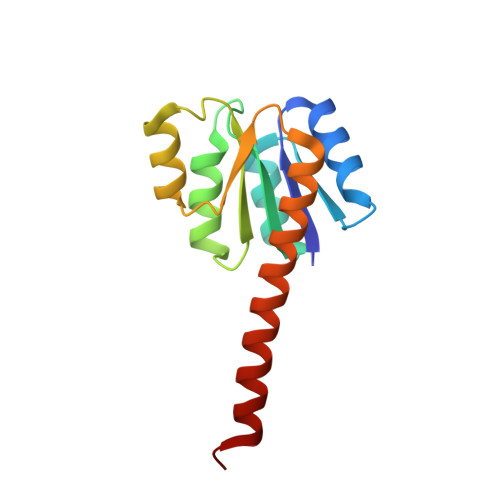The Hupr Receiver Domain Crystal Structure in its Nonphospho and Inhibitory Phospho States.
Davies, K.M., Lowe, E.D., Venien-Bryan, C., Johnson, L.N.(2009) J Mol Biology 385: 51
- PubMed: 18977359
- DOI: https://doi.org/10.1016/j.jmb.2008.10.027
- Primary Citation of Related Structures:
2JK1, 2VUH, 2VUI - PubMed Abstract:
Hydrogen uptake protein regulator (HupR) is a member of the nitrogen regulatory protein C (NtrC) family of response regulators. These proteins activate transcription by RNA polymerase (RNAP) in response to a change in environment. This change is detected through the phosphorylation of their receiver domain as part of a two-component signalling pathway. HupR is an unusual member of this family as it activates transcription when unphosphorylated, and transcription is inhibited by phosphorylation. Also, HupR activates transcription through the more general sigma(70) transcription initiation factor, which does not require activation by ATPase, in contrast to other NtrC family members that utilise sigma(54). Hence, its mode of action is expected to be different from those of the more conventional NtrC family members. We have determined the structures of the unphosphorylated N-terminal receiver domain of wild-type HupR, the mutant HupR(D55E)(N) (which cannot be phosphorylated and down-regulated), and HupR in the presence of the phosphorylation mimic BeF(3)(-). The structures show a typical response regulator fold organised as a dimer whose interface involves alpha4-beta5-alpha5 elements. The interactions across the interface are slightly different between apo and phospho mimics, and these reflect a rearrangement of key conserved residues around the active site aspartate that have been implicated in domain activation in other receiver domain proteins. We also show that the wild-type HupR receiver domain forms a weak dimer in solution, which is strengthened in the presence of the phosphorylation mimic BeF(3)(-). The results indicate many features similar to those that have been observed in other systems, including NtrC (where phosphorylation is activatory), and indicate that recognition properties, which allow HupR to be active in the absence of phosphorylation, lie in the transmission of phosphorylation signals through the linker region to the other domains of the protein.
- Laboratory of Molecular Biophysics, Department of Biochemistry, University of Oxford, Oxford, UK.
Organizational Affiliation:

















